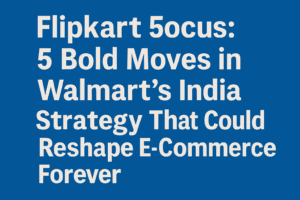Flipkart Focus: 5 Bold Moves in Walmart’s India Strategy That Could Reshape E-Commerce Forever
Walmart CEO Doug McMillon confirms a definitive shift in India strategy: abandoning physical retail (“not pursuing” brick-and-mortar) to double down on its $16 billion Flipkart investment. The company actively seeks a “level-playing field,” specifically pushing for foreign e-commerce access to the inventory-based model currently restricted by Indian regulations – a key competitive hurdle. While committed to compliance, Walmart persistently advocates for rule changes it believes would benefit customers and the economy.
Flipkart is accelerating into quick commerce, prioritizing customer growth and market share over immediate profits, leveraging its 500-million user base. India’s role is also expanding as a critical, diversified sourcing hub for Walmart’s global supply chain resilience (“China+1”). Despite Amazon’s current revenue lead, McMillon expresses strong long-term conviction in Flipkart and Indian e-commerce, betting on patience and persistent policy dialogue over quick fixes. Their strategy hinges on navigating regulations while aggressively scaling Flipkart.

Flipkart Focus: 5 Bold Moves in Walmart’s India Strategy That Could Reshape E-Commerce Forever
Walmart’s global leadership isn’t sugarcoating their ambitions or frustrations in India. In a revealing interview, CEO Doug McMillon and Walmart International head Kathryn McLay outlined a clear, patient, yet assertive strategy centered on Flipkart and navigating a complex regulatory landscape. Here’s the nuanced reality behind their statements:
- The Persistent Policy Puzzle: Craving a Level Playing Field McMillon’s core message was unambiguous: Walmart seeks “a level-playing field” globally, and in India, that specifically means access to the inventory-based model currently restricted for foreign-owned e-commerce players. “We like managing inventory,” McMillon stated, acknowledging its difficulty but highlighting Walmart’s core expertise. “Hopefully, at some point, that will happen.” This isn’t just about convenience; it’s about operational efficiency and potentially lower costs for consumers. The current rules, allowing Indian competitors to hold inventory while restricting Flipkart and Amazon to a marketplace model, remain a significant point of contention. McMillon framed their approach pragmatically: “Job one is to be compliant… Job two is to communicate… what we think rules could look like that would help support the economy.”
- Brick-and-Mortar Exit: A Strategic Retreat Confirmed Walmart slammed the door firmly on pursuing its own physical retail stores in India for the foreseeable future. “That’s not something we are pursuing. We have learnt that that’s very difficult,” McMillon stated bluntly. This is a stark admission of the challenges faced navigating India’s FDI regulations and local competition in the offline space. Their energy and investment are now singularly focused: “We are very excited to have invested in Flipkart.” This marks a significant strategic shift from their earlier wholesale cash-and-carry experiments.
- Flipkart’s Fast Lane: Speed Over Short-Term Profits in Quick Commerce Acknowledging Flipkart’s later entry into the hyper-competitive quick commerce (10-15 minute delivery) space, McLay expressed strong confidence. She praised the team’s execution speed: “They moved with speed… they continue to blow our minds.” Crucially, she signaled Walmart’s tolerance for significant investment, prioritizing growth and customer acquisition over immediate profitability: “We are interested in… positioning around growth and market share, and delighting the customers before we focus on profits.” Flipkart’s massive potential customer base – 500 million users – is the foundation justifying this potential “cash burn.”
- Supply Chain Shifts: India’s Rising Sourcing Star Both leaders emphasized India’s growing importance in Walmart’s global supply chain diversification (“China+1”). McLay highlighted the lesson from Covid: “Over-reliance on any particular trade route… could be very disruptive.” Building a “resilient supply chain” is paramount. McMillon noted a positive evolution: “We were buying a lot of soft goods… now, we are buying food items, more general merchandise.” India’s manufacturing breadth is expanding, and Walmart sees it as “a great option.” While McMillon stressed Walmart’s commitment to local sourcing where possible (over two-thirds in the US), India is clearly becoming a critical, diversified sourcing hub for their global operations.
- The Long Game: Confidence Amidst Competition Despite Amazon’s revenue lead in India currently, McMillon radiated confidence in Flipkart and the Indian e-commerce market: “Flipkart has a really bright future and I am really thankful that we made the investment when we did.” He views e-commerce growth, particularly in India, as a long-term inevitability. The $16 billion bet on Flipkart in 2018 remains central to their entire India strategy.
The Human Insight: Strategic Patience Meets Persistent Advocacy
Walmart’s India playbook reveals several key truths:
- Deep Commitment, Deep Frustration: Their massive Flipkart investment shows long-term commitment, but the inventory model restriction remains a major operational and competitive hurdle they will continue to diplomatically challenge.
- Realistic Retreat: Abandoning their own physical stores acknowledges the immense difficulty in that space, freeing resources for the digital battle.
- Investment Over Immediate Returns: Flipkart’s quick commerce push, backed by Walmart’s deep pockets, signals a willingness to spend heavily to win market share and mindshare in a critical growth segment.
- India as a Global Sourcing Pillar: Beyond the e-commerce battle, India’s role as a diversified manufacturing source is strategically vital for Walmart’s global resilience.
Walmart is playing a complex, high-stakes game in India. They are compliant publicly but persistently advocate for change. They’ve retreated from one front to double down on another. They’re investing for the distant horizon while navigating daily competitive and policy pressures. Their success hinges not just on Flipkart’s execution, but also on whether the “level playing field” McMillon seeks ever materializes.
You must be logged in to post a comment.